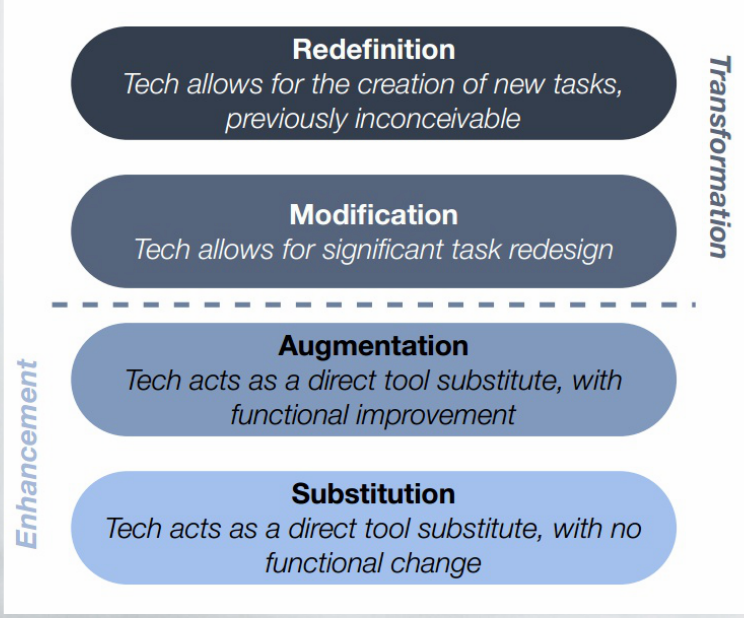
The four-stage Substitution, Augmentation, Modification, and Redefinition (SAMR) model introduced by Rueben Puentedura back in mid-2000 has not only grown in popularity there are people building upon this its unsubstantiated foundation. The SAMR model was initially intended to help K-12 teachers move the up the ladder of technology use by using tech for the creation of new tasks, tech for a significant redesign, tech as a direct substitute with functional improvement, and tech as a direct substitute, with no functional change. SAMR not only looks like an innocuous model of using technology it also seems to appeal to the way many people tend to approach the use of technology. If we look closely at the fundamental presupposition of its use then we will see that there are serious issues in how the model can enhance learning.
The first time I was introduced to the SAMR model was over a decade ago and I recall thinking that this model has a fundamental flaw that many people will tend to overlook. While using technology to simply make an activity or task more efficient or to explore ways to enhance or even redefine that activity or task may seem innocuous or even worthwhile the problem that we run into with this sort of thinking is that we are ignoring the validity of the original task that SAMR is being applied to. For example if you use SAMR to move your paper-based fill in the black worksheet to a digital model (substitution) and then add some branching questions in a google form (augmentation) and then add enabled voice responses (modification) and finally allow your class to create a video to answer the questions (redefinition) the problem is you are still asking your students to regurgitate content regardless how sophisticated the regurgitation becomes. I have also noticed in my time working with hundreds of teachers and faculty that there is a tendency for most people to NOT move beyond the substitution or argumentation level. This means many well-intentioned instructors are not heading Seymour Papert’s warning and are falling into the trap of bolting a jet engine onto a horse cart.
I agree that we should be using technology to become more administratively efficient and to help the guide our learners but we should be using technology to go well beyond the original teaching task and use technology to enhance the learning not just use technology to enhance the use of technology. I am not alone in this thinking. The following articles and sites point to many of the same concerns that I have and develop several others. Another major concern is that the SAMR model has not been well researched as you can see from one of few articles that looks at the model itself.
Hamilton, E. R., Rosenberg, J. M., & Akcaoglu, M. (2016). The substitution augmentation modification redefinition (SAMR) model: A critical review and suggestions for its use. TechTrends, 60(5), 433–441.
Like the title indicates the article offers criticism of the SAMR model and recommendations for how it can be used effectively. This article can be downloaded from any academic library.
SAMR: A model without evidence – https://charlielove.org/?p=10025
A very fair assessment of the SAMR model that points to several related sources.
A Critical Review of Puentedura’s SAMR – http://eitcclips.blogspot.com/2015/03/picking-holes-in-samr-critical-review.html
Another fair assessment points to the lack of theoretical or foundational evidence for SAMR.
Through The Looking Glass by Lucy Santos Green – http://www.lucysantosgreen.com/uploads/6/8/3/3/6833178/through_the_looking_glass.pdf
A fair assessment of the SAMR and TPACK models and recommendations on how they can be used more appropriately.
Revised January 24, 2021































The weaknesses of SAMR are obvious and inescapable. However this critique ignores the reality of teacher unfamiliarity and insecurity in integrating technology into the pedagogical process. The alternative to using the baby steps of SAMR is generally no integration at all rather than more effective use of technology to enhance learning. This is particularly true when integrating across a whole school board Rather than in a single classroom. Refining the pedagogical approach is a separate and parallel process to learning g the uses of technology. In other words, we should be eliminating worksheets and rote learning anyway, whether with tech or on paper. We already know that if our horse is old, lame or ill we need to replace it in order to move along.